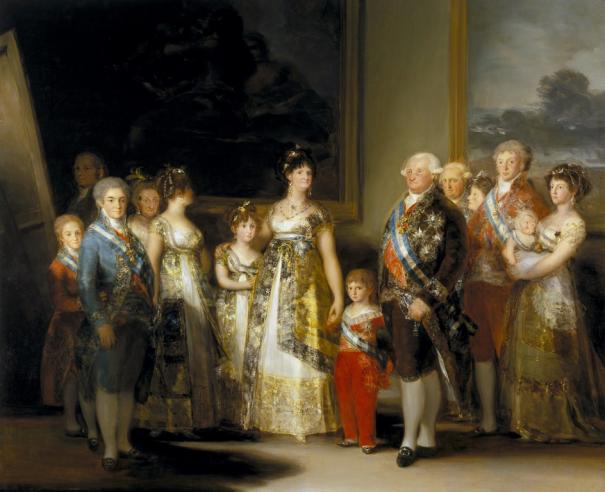Family of Carlos IV
Alisa Luxemberg describes some nineteenth-century responses to Goya’s Family of Carlos IV :
“In fact, this colorful description of Goya’s canvas first appeared in Lucien Solvay’s L’Art espagnol, published in Paris and London in 1887. Solvay penned the phrase as his positive response to Goya’s truthfulness in the royal portrait…
[The Family of Charles IV] has numerous points of resemblance with any decent
family of grocers who might have had themselves portrayed on a lucky day, stiff and
formal, in their Sunday best.
…In many late 19th-century art publications, Goya was considered a democratic engagé, an artist of the people. A royal portrait commission like The Family of Charles IV troubled these expectations of an independent artist freely choosing his subjects and painting without having to cater to sitters’ demands. Seeing the portrait as caricature, however, fit nicely with the critics’ belief that Goya was, at heart, a republican, not a monarchist….
In nineteenth-century Spain, Goya’s paintings and the Family of Charles IV, received mixed commentary, but were never compared to caricature. The painter, restorer, and critic Ceferino Araujo Sanchez disparaged Goya’s painting in an important publication on Spanish museums….Araujo Sanchez specifically stated that the Family of Charles IV and The Third of May, 1808 were not Goya’s masterpieces. The low esteem in which Goya’s royal portrait was held may be reflected in an 1863 photographic catalogue of works in the royal museum (not yet called the Prado), which did not include this or any other work by Goya….
Two French publications written for comfortable, not particularly well-educated tourists treat the royal portrait as a failed work. In 1869, the Countess de Gasparin described her book as ‘not an erudite work’ and herself as ‘a simple tourist’ visiting Spain for the first time. She considered Goya’s group portrait to be a horrific revelation of ugliness and madness:
Charles IV shows us his prodigious nose, a kind of fig or eggplant, an
enormous protuberance, fleshy, bruised, that is embedded in the middle of
a stupid physiognomy, hanging bestially from his forehead over stupefied
lips. His wife, of a repugnant ugliness that reveals the vices of her soul, is
also portrayed…there in full length…always with a look of fury, violent and
coquettish…a kind of monster required for the idolatrous temples of the Fiji
islands…Let’s assume that she was crazy and not speak any more about
her.”
Alisa Luxemberg, “Further Light on the Critical Reception of Goya’s Family of Charles IV as Caricature,” Artibus et Historae, vol. 23, n. 46 (2002): 179-81.
Fred Licht offers an explanation for the positive reception of Goya’s Family of Carlos VI at the time of its painting:
“The original question concerning the acceptability of such an unflattering group portrait is now no longer quite so enigmatic. The reason Goya could get away with his unashamedly naked revelation of his sitters’ appearance lies in the intricate situation he has set up, which is derived from the common procedure used in self-portraits. Goya has not presented his sitters as he saw them. He has presented them as they saw themselves. He records the unimpeachable evidence provided by the sitters themselves. We do not have in this painting an aesthetically conditioned image for which the artist takes full responsibility; the artist has abdicated his traditional prerogative, that of interpreting reality by recasting it in accordance with the dictates of his personal style….Goya relinquishes the position of an agent who transmits an ideally transformed reality by means of an inspired act of creation. Instead, he bears witness to the existence of certain phenomena without deigning to become involved in the meaningful interpretation of the truths to which he testifies. If we wish to draw conclusions about the meaning of paintings such as this, we do so at our own risk.”
Fred Licht, “Goya’s Portrait of the Royal Family,” The Art Bulletin, vol. 49, n. 2 (June 1967): 128.
About the Artist
Died: Bordeaux, France, 16 April 1828
Nationality: Spanish


 Buy the Book
Buy the Book